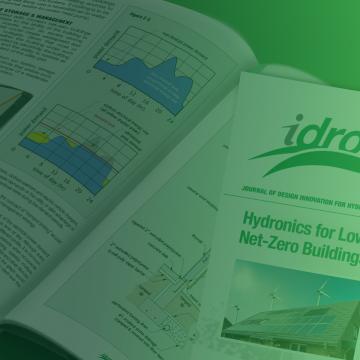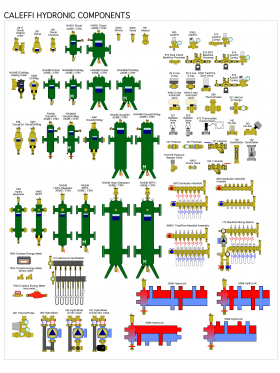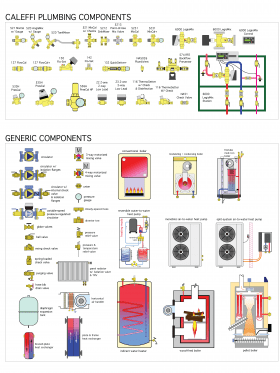APPENDIX A: CALEFFI HYDRONIC COMPONENTS
APPENDIX B & C: CALEFFI PLUMBING AND GENERIC COMPONENTS
APPENDIX D: ESTIMATING PANEL RADIATOR HEAT OUTPUT AT REDUCED WATER TEMPERATURES
In North America, the published data for heat output from panel radiators is typically based on high water temperatures. The most common being an average water temperature of 180ºF, and an assumed room air temperature of 68ºF. This makes the difference between the average water temperature in the radiator and the room air temperature 180 - 68 = 112ºF. This temperature difference, or ΔT, is a reference condition that can be used as part of the following procedure, based on European standard EN442, to determine the output of panel radiators at lower water temperatures. The general relationship between the heat output of a panel radiator and the difference between the average water temperature at which it operates and the surrounding air temperature is given by Formula B1.
Formula B1:
$$ Q_e = Q_{112} \Biggl( {{\Delta T_d} \over {112}} \Biggl) ^{1.3}$$
Where:
$Q_e$ = estimated heat output of the panel radiator (Btu/hr)
$\Delta T_d$ = temperature difference determined using either Formula B2 or Formula B3 below (ºF)
$Q_{112}$ = the output of the panel radiator when the difference between the average water temperature and room air temperature is 112ºF (Btu/hr) (e.g., average water temperature = 180ºF, and room air temperature = 68ºF) 1.3 = an exponent (not a multiplier) (use [yx] key on scientific calculator or your smart phone)
The value to be used for $ \Delta T_d$ is based on either Formula B2 or B3:
Formula B2:
$$ \Delta T_d = \Bigg[ \Bigg({T_{in} + T_{out} \over 2} \Bigg) - T_{air} \Bigg] $$
Formula B3:
$$ \Delta T_d = {T_{in} - T_{out} \over ln \Bigg( {T_{in} - T_{air} \over T_{out} - T_{air}} \Bigg)} - T_{air} $$
Where:
$ \Delta T_d$ = effective temperature difference (ºF)
$T_{in}$ = inlet water temperature to panel (ºF)
$T_{out}$ = outlet water temperature from panel (ºF)
$T_{air}$ = room air temperature (ºF)
$ln$ = natural logarithm function (use [ln] key on scientific calculator or your smart phone)
Another formula, (B4), is used to determine if Formula B2 or Formula B3 should be used to calculate $\Delta T_d$.
Formula B4:
$$ u = { (T_{out} - T_{air}) \over (T_{in} - T_{air}) }$$
Where:
$T_{out}$ = outlet fluid temperature from panel (ºF)
$T_{in}$ = inlet fluid temperature to panel (ºF)
$T_{air}$ = room air temperature (ºF)
If the calculated value of u from Formula B4 is less than 0.7, use Formula B3 to calculate $\Delta T_d$.
If the calculated value of u from Formula B4 is greater than or equal to 0.7, use Formula B2 to calculate $\Delta T_d$.
For example, assume water enters the panel radiator at 115ºF, and exits at 92ºF. The air temperature in the room is 65ºF. Determine the correct $\Delta T_d$ to use in Formula 1.
Solution: Start by calculating the value of u using Formula B4:
$$ u = { (T_{out} - T_{air}) \over (T_{in} - T_{air}) } = { (92 - 65) \over (115 - 65) } = 0.54 $$
Since 0.54 < 0.7 use of Formula B3 to calculate $\Delta T_d$:
$$ \Delta T_d = {(T_{in} - T_{out}) \over ln \Bigg( {T_{in} - T_{air} \over T_{out} - T_{air}} \Bigg)} = {(115 - 92) \over ln \Bigg( {115 - 65 \over 92 - 65} \Bigg)} = {23 \over ln({50 \over 27})}= {23 \over ln(1.85185)} = 37.33^oF $$
Now that the appropriate value of $\Delta T_d$ has been determined, the final step is to plug the numbers into Formula B1:
$$ Q_e = Q_{112} \Biggl( {{\Delta T_d} \over {112}} \Biggl) ^{1.3} = 9500 \Biggl( {{37.33} \over {112}} \Biggl) ^{1.3} = 2277 {Btu \over hr}$$
This is about one quarter of the “rated” heat output of the panel when the average water temperature is 180ºF and the assumed room temperature is 68 ºF. When searching manufacturer’s rating tables for an appropriately sized panel radiator, it’s sometimes necessary to work this procedure “backwards.”
For example, consider a room with a design load of 2,500 Btu/hr. Assume that the panel radiator in this room will be supplied with water at 115ºF and operate with a 25ºF temperature drop. The room temperature will be 70ºF. Use the above procedure “in reverse” to find an appropriately sized radiator based on output at an average water temperature of 180ºF and a room temperature of 68ºF.
Solution: Start with Formula B4:
$$ u = { (T_{out} - T_{air}) \over (T_{in} - T_{air}) } = { (90 - 70) \over (115 - 70) } = 0.44 $$
Since u < 0.7 use Formula B3 to get $\Delta T_d$:
$$ 2500 = Q_{112} \Bigg( {30.83 \over 112} \Bigg)^{1.3} $$
This can be solved for the necessary output at the $\Delta T_d$ =112ºF:
$$ Q_{112} = {(2500) \over \Big({30.83 \over 112} \Big)^{1.3}} = 13,374{Btu \over hr} $$
At this point, the designer can look through a table of radiator ratings based on an average water temperature of 180ºF and a room air temperature of 68ºF to find one or more panel radiators that can output approximately 13,400 Btu/hr. Based on data from one manufacturer, a radiator with three water plates, a height of 24 inches, and length of 48 inches has an output of 13,664 Btu/hr, which is very close to calculated output at $\Delta T_d$ = 112ºF. A radiator with three water plates that is 20 inches high and 64 inches long has a listed output of 15,829 Btu/hr — more than enough.



